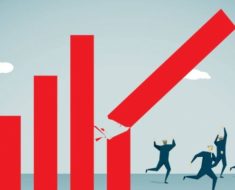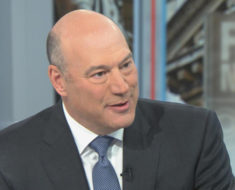Ted Bauman’s finance career has taken him to most countries across the globe. But unlike his more avaricious peers, Ted Bauman has chosen as his life’s work not the pursuit of personal wealth but making a difference in the lives of the economically disadvantaged. Bauman has been a founding team member on a number of high-profile nonprofit ventures, including Slum Dwellers International. He has also been a key figure in the global poverty-mitigation efforts of both the United Nations and the World Bank.
Since the year 2000, Ted Bauman has been helping ordinary people to realize economic prosperity through low-risk investment strategies. He is currently the author of the widely read newsletter “The Sovereign Investor Daily”, which helps people to attain financial independence through sound investing.
Cracks in the Economy
Like most value investors, Ted Bauman heavily weighs economic fundamentals while generally eschewing technical indicators. Yet, there are a few leading indicators that Bauman says have a strong basis in both logic and fact. One of those is yield curve inversion.
In his recent letter, Bauman explains that yield curves normally follow a gentle upward trajectory where bonds with the longest maturities tend to have the highest yields. This, he says, is a reflection of the fact that bonds with later maturity dates carry what investment professionals refer to as maturity risk, the essence of which is the chance that interest rates could move significantly higher than the bond’s nominal interest rates. This, in turn, would cause the value of those bonds to collapse when markets adjust the price of the lower-interest bond so that it has a nearly identical yield to the bonds that are now issued with higher interest rates.
Bauman says that the mechanics of the bond market often confuse those new to economics. But he simplified things with an easily remembered relationship: Yield is the opposite of price. When the price of a bond rises, its yield necessarily declines. And when its yield has risen, that means that its price has declined.
A Leading Indicator You Shouldn’t Ignore
Unlike many technical indicators, there is a strong, unambiguous and logically rigorous reason that yield-curve inversions may signal coming recessions. Additionally, Bauman points out that the empirical record of using inverted yield curves to predict recessions has been perfect the last seven times that this phenomenon has occurred.
When short-term bonds have higher yields than bonds with longer maturities, this is a signal that investors are looking to lock in the yields of the longer-term bonds in lieu of assuming the risk that when shorter-term bonds mature, there will only be much lower-yielding bonds to choose from to replace them.
But why does this mean investors see a significantly weakened economy? Bauman says that the key takeaway is that much-increased demand for long-term bonds versus short-term bonds signals that investors anticipate that demand for those short-term bonds is going to increase markedly. The reason that demand for bonds will increase markedly in a bad economy is that investors will not want to put their money in equities, which represent businesses that rely 100 percent on the health of the economy, mostly the consumer economy, for their profitability. When the economy is bad, business is bad. And bad business means poorly performing stocks.
So, in an economic downturn, investors pile into the guaranteed return that bonds offer. But if the economy is going to be in bad shape in one year, investors are not going to want to buy bonds that mature in a year’s time because they anticipate that there will be extremely high demand for the bonds that they will then be forced to buy in order to replace their bonds that will mature in a year. With extremely high demand comes extremely low yields. Therefore, investors who see economic trouble ahead seek to lock in long-term yields by going after bonds with longer maturities. But this increased demand pushes down those yields. In extreme cases, where investors perceive the economic future to be particularly dire, that demand for long-term bonds can be so great that it actually exceeds the demand for short-term bonds. Bauman explains that such a scenario produces an inverted yield curve.
Other Corroborating Factors
Bauman has repeatedly struck a bearish tone over the last few years on the country’s macroeconomic outlook. But now, he says that a prolonged economic slowdown and a possible recession are all but inevitable.
However, Bauman never makes his investment decisions based on one or even two factors alone. While Bauman has stated that yield curve inversions are among the most potent macroeconomic indicators, he argues that there are many other signs that are unambiguously pointing to the inevitability of an economic downturn.
Consumer Debt and Falling Living Standards
As one of the world’s leading experts on public housing in the context of extreme poverty, Bauman has an understanding of the dynamics of poverty that few others can match. In his capacities with the United Nations and organizations like Slum Dwellers International, Bauman has witnessed the realities of extreme poverty with his own eyes. And his experiences have taught him unforgettable lessons about what factors can lead to it.
Unfortunately, Bauman says that many of the macroeconomic features that he saw Nairobi, Harare and Capetown are now beginning to take shape in the United States. Among those is the slow yet inexorable destruction of the middle class. Bauman says that one of the common features of all the places he worked in which abject poverty was endemic was extreme inequality in the distribution of wealth.
In the United States, Bauman says that rapidly increasing debt, falling median wages and asset inflation are all contributing to the slow-but-certain death of the middle class. This is creating the same haves-have-nots dichotomy that he’s seen in countries from Brazil to the Congo. The bad news, says Bauman, is that the economies of those countries are structured much differently than our own, with most economic activity taking place between large corporations and rich individuals, alongside shocking levels of corruption and violence. The latter two, says Bauman, can produce negative feedback loops that are almost impossible to break and that put hard ceilings on the level of economic prosperity that a country can achieve. He points out that the per-capita income of the U.S. is $60,000 while it is just $15,000 in Brazil and a hair-raising $870 in the Democratic Republic of the Congo.
Bauman warns strongly against those who blithely reply that the United States is the unipolar hegemon and has always been and will always be an economic powerhouse. Bauman says that such arrogant dismissals precede great falls. And he reminds people that economies with high wealth inequality and ultra-high levels of both consumer and government debt have almost never failed to produce violence, corruption and heart-rending poverty. He says that Americans should be forewarned that we may not be nearly as exceptional as our elites would have us believe.
Ultimately, Bauman says that not only is a recession all but inevitable in our near-term future, but a long-term decline of our economy as a whole is virtually guaranteed unless the factors that have unfailingly led to poverty and despair throughout the world are addressed.
Want to learn more about Ted Bauman and his newsletter The Bauman Letter? Click here for more information.
Dil Bole Oberoi





